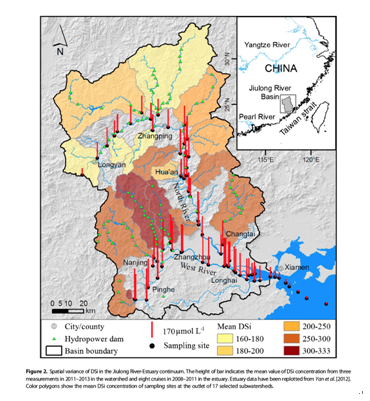Nengwang Chen, Yinqi Wu, Jiezhong Wu, Xiuli
Yan, and Huasheng Hong.Biogeoscience, 2014. 119: 95-109.
Natural and human factors controlling
dissolved silica (DSi) export from the watershed were investigated for the
Jiulong River watershed in Southeast China, which is a subtropical region where
tectonic activity and high runoff combine to create a global hot spot for DSi
flux. Results showed that river DSi was fairly high (246 ± 76 µmol
L−1) due to granite lithology and increased human perturbation. The
percentage of granite, paddy soil, arable land, and forest land each explain
47–69% of the spatial variation in DSi level at the subwatershed scale. Land
use change (deforestation for agriculture) and soil erosion increased DSi transfer
from terrestrial systems towards the river. Discharge explains over 95% of the
variation in DSi fluxes, and a discrepancy of up to 16% of watershed DSi export
was observed between low and high flow conditions. DSi retention is more
significant in the dry season, likely due to biological uptake by diatoms in
reservoirs under low flow conditions and higher residence time. However, this
may be offset by high runoff flush in the wet season, which might cause
unfavorable conditions for diatom growth and DSi depletion. There has been
little overall change in DSi in estuarine water in recent decades. However,
seasonal variation and occasionally fluctuation of DSi during extreme
hydrological events (rainstorms) does exist, with important implications for
the coastal ecosystem. This research confirmed that human activities and land
use change have substantially altered Si delivery, cycling and riverine export
to the coast in this region.

返回

